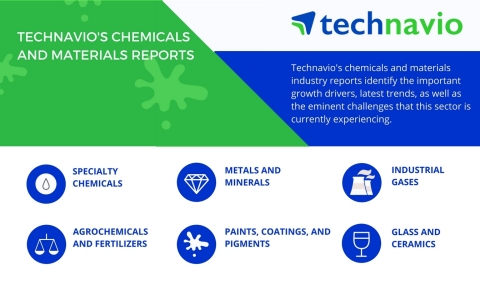Key Findings of the Global Eco Fiber Market | Technavio
The latest market research report by Technavio on the global eco fiber market predicts a CAGR of close to 11% during the period 2018-2022.
This press release features multimedia. View the full release here: https://www.businesswire.com/news/home/20180415005117/en/

Technavio has published a new market research report on the global eco fiber market 2018-2022 under their chemicals and materials library. (Graphic: Business Wire)
The report segments the global eco fiber market by application (textile, household and furnishing, industrial, and medical), by product type (regenerated fibers, organic fibers, and recycled fibers), and by geography (the Americas, EMEA, and APAC). It provides a detailed illustration of the major factors influencing the market, including drivers, opportunities, trends, and industry-specific challenges.
Here are some key findings of the global eco fiber market, according to Technavio chemicals and materials researchers:
- Environmental damage caused by conventional fibers: a major market driver
- Growing awareness about sustainable textile production: emerging market trend
- APAC dominated the global eco fiber market with 38% share in 2017
- In 2017, the textile segment held the highest market share of nearly 50%
This report is available at a USD 1,000 discount for a limited time only: View market snapshot before purchasing
Save more with Technavio. Buy 2 reports and get the third for FREE: View all Technavio’s current offers
Environmental damage caused by conventional fibers: a major market driver
The production of both natural fibers and synthetic fibers has a significant effect on the environment. Non-organic cotton, which has the highest production rate, is grown using conventional methods. The cultivation process requires large amounts of water and pesticides. 2,500 liters of water is required to produce a cotton shirt. An extensive amount of pesticides, herbicides, insecticides, and fertilizers are required for the forming of cotton. In cotton farms, nitrate fertilizers are used that gets converted into nitrous oxide, which is a greenhouse gas that contributes towards global warming.
Further down the value chain, large quantities of chemicals, energy, and water are required to prepare dye cotton fabric. Conventional rayon that is prepared from cellulose is a natural fiber that requires large amounts of chemicals in the fiber spinning phase. Synthetic fibers such as polyester and other petroleum-based fibers depend on non-renewable oil resources.
Looking for more information on this market? Request a free sample report
Technavio’s sample reports are free of charge and contain multiple sections of the report including the market size and forecast, drivers, challenges, trends, and more.
Growing awareness about sustainable textile production: emerging market trend
In several countries, globalization has led to significant economic growth. Environmental issues pose a serious challenge to the government. The increasing adoption of sustainable practices is expected to reduce environmental damages. Globally, the increasing focus on the environment has led a number of companies to produce environment-friendly products. Research activities are undertaken to develop solutions that will help in reducing pollution, global warming, and other environmental issues.
There has been an increase in popularity of sustainable textile fibers, which includes organic cotton, flax, hemp, jute, sisal, abaca, and bamboo. Renewable and biodegradable synthetic fibers manufactured from natural resources such as polylactic acid and lyocell are being preferred over petroleum-based non-biodegradable synthetic fibers such as polyester.
According to a senior analyst at Technavio for research on textile, fiber, and composites, “In the textile industry, there is a high rate of adoption of organic fibers due to the growing focus on environmental issues and the availability of numerous alternatives. This is expected to contribute significantly towards the growth of the global eco fiber market.”
Global market opportunities
In terms of regional dominance, APAC led the global eco fiber market, followed by the Americas and EMEA in 2017. In APAC, the increasing demand for eco fibers in several industries such as textile, manufacturing, and export is driving the market. In developing economies such as China and India, industries are expanding rapidly. In the Americas, the increasing demand for eco fibers in textile applications is driving the market.
|
Technavio’s best deals of the month! |
|
Technavio supports Health for All campaign on this World Health Day with 20% savings on all reports in the Health and Wellness category for the entire month. |
|
OR |
|
Celebrate International Astronomy Day by indulging in a whopping 30% savings on all reports in the Space category. Offer valid from 16th April for a limited period. |
About Technavio
Technavio is a leading global technology research and advisory company. Their research and analysis focuses on emerging market trends and provides actionable insights to help businesses identify market opportunities and develop effective strategies to optimize their market positions.
With over 500 specialized analysts, Technavio’s report library consists of more than 10,000 reports and counting, covering 800 technologies, spanning across 50 countries. Their client base consists of enterprises of all sizes, including more than 100 Fortune 500 companies. This growing client base relies on Technavio’s comprehensive coverage, extensive research, and actionable market insights to identify opportunities in existing and potential markets and assess their competitive positions within changing market scenarios.
If you are interested in more information, please contact our media team at media@technavio.com.
View source version on businesswire.com: https://www.businesswire.com/news/home/20180415005117/en/

